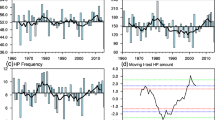Abstract
The period of prolonged summer rain in Korea called Changma was studied. Changma, also known as Meiyu in China and Baiu in Japan, is an integral part of the East Asian Summer Monsoon System. Until the 1980s, the Changma rainy season in Korea occurred from late June and July for 30 to 40 days or approximately 4 to 5 weeks. This study investigated whether changes have been observed in the timing and amounts of precipitation associated with Changma. From the analysis of meteorological data obtained in 2017 and 2018, it is observed that the length of the rainy season has shortened to 2 to 3 weeks in agreement with the earlier studies. Furthermore, during the rainy season, there were many days of no rain and partly cloudy days. Although an active elongated-linear Changma front was common in the past, it was found that an inactive Changma front with a large meridional amplitude has caused intermittent rain showers for several hours from linear convective cloud streaks. In recent years, this has produced large variations in rainfall amounts among regional measuring stations in Korea. Climate warming in the north side of the Changma front has resulted in less contrast with the warm-moist air in the south side of it from the Pacific Ocean. This has resulted in a weaker and inactive quasi-stationary front which has caused a discontinuous broken Changma front and sporadic showery days. It is also observed that maritime polar air mass, mP, over the Okhotsk Sea of far eastern Russia has not affected the Changma front over the Korean Peninsula. Overall, this study found that the characteristics of past Changma fronts have changed significantly in recent years. The present observations imply the need of further studies on climate change and summer rainfall including water management.


















Similar content being viewed by others
Notes
Changma is originated from the Korean words for “prolonged rainy period” in summer. Meiyu in Chinese and Baiu in Japanese both mean “plum rain,” indicating a rainy season with ripening plums. The terms Meiyu and Baiu also seem to have originated from the Chinese character for mold, an unpleasant environment of persistent warm, damp and rainy conditions.
References
Chung YS (1977) An observational study of the influence of large-scale mountains on air flow and lee cyclogenesis. Arch Meteorol Geophys Bioklimatol A 26:109–126
Chung YS, Dulam J (2004) Anticyclones over the territory of Mongolia. J Korean Meteor Soc 40–3:317–329
Chung YS, Hage KD, Reinelt ER (1976) On lee cyclogenesis and airflow in the Canadian Rocky Mountains and the east Asian Mountains. Mon Weather Rev 104:879–891
Chung YS, Kim HS (2008) Observations of massive air-pollution transport and associated air quality in the Yellow Sea region. Air Qual Atmos Health 1:69–79
Chung YS, Yoon MB (1999) Recent climate change and related factors observed in Korea. J Korean Meteor Soc 35-3:309–318
Chung YS, Yoon MB (2000) Interpretation of recent temperature and precipitation trends observed in Korea. Theor Appl Climate 67:171–180
Chung YS, Yoon MB, Kim HS (2004) On climate variations and changes observed in South Korea. Clim Chang 66(1/2):151–161
Jugder D, Chung YS (2002) Observed climate variability and change in Mongolia. J Korean Meteor Soc 38-6:593–609
Kato K (1989) Seasonal transition of the lower-level circulation systems around the Baiu front in China in 1979 and its relation to the northern summer monsoon. J Meteor Soc Japan 67:249–265
Kim HS, Chung YS, Tans PP (2014) A study on carbon dioxide concentrations and carbon isotopes measured in East Asia during 1991~2011. Air Qual Atmos Health 7:173–179
Korea Meteorolical Administration (KMA) (2012) Climate atlas of Korea, 1981~2010, 174
Luo Y, Chen Y (2015) Investigation of the predictability and physical mechanisms of an extreme-rainfall-producing mesoscale convection system along the Meiyu front in East China: an ensemble approach. J Geophys Res 120(20):10,593–10,618
Qian W, Zhu Y (2001) Climate change in China from 1880 to 1998 and its impact on the environmental conditions. Clim Chang 50-4:419–444
Sampe T, Xie SP (2010) Large-scale dynamics of the Meiyu-Baiu rain band: environmental forcing by the westerly jet. J Clim 23(1):113–134
Shen D, Varis O (2001) Climate change in China. AMBIO 30(6):381–383
Xu X, Lu C, Shi X, Ding Y (2010) Large-scale topography of China: a factor for the seasonal progression of the Meiyu rain band? J Geophys Res D02110:115–1D2
Yasunari Y, Miwa T (2006) Convective cloud systems over the Tibetan Plateau and their impact on meso-scale disturbances in the Meiyu/Baiu frontal zone. J Meteor Soc Japan 84(4):783–803
Acknowledgements
We thank the KMA for providing science subvention of the Project (KMI2017-7020). Also, Ms. Cho JH has drawn a figure.
Author information
Authors and Affiliations
Corresponding author
Additional information
Publisher’s Note
Springer Nature remains neutral with regard to jurisdictional claims in published maps and institutional affiliations.
Electronic supplementary material
ESM 1
(DOCX 4703 kb)
Rights and permissions
About this article
Cite this article
Chung, Y.S., Kim, H.S. Observations on changes in Korean Changma rain associated with climate warming in 2017 and 2018. Air Qual Atmos Health 12, 197–215 (2019). https://doi.org/10.1007/s11869-018-00658-5
Received:
Accepted:
Published:
Issue Date:
DOI: https://doi.org/10.1007/s11869-018-00658-5



